Story by Ryan Hoover | UW ECE News
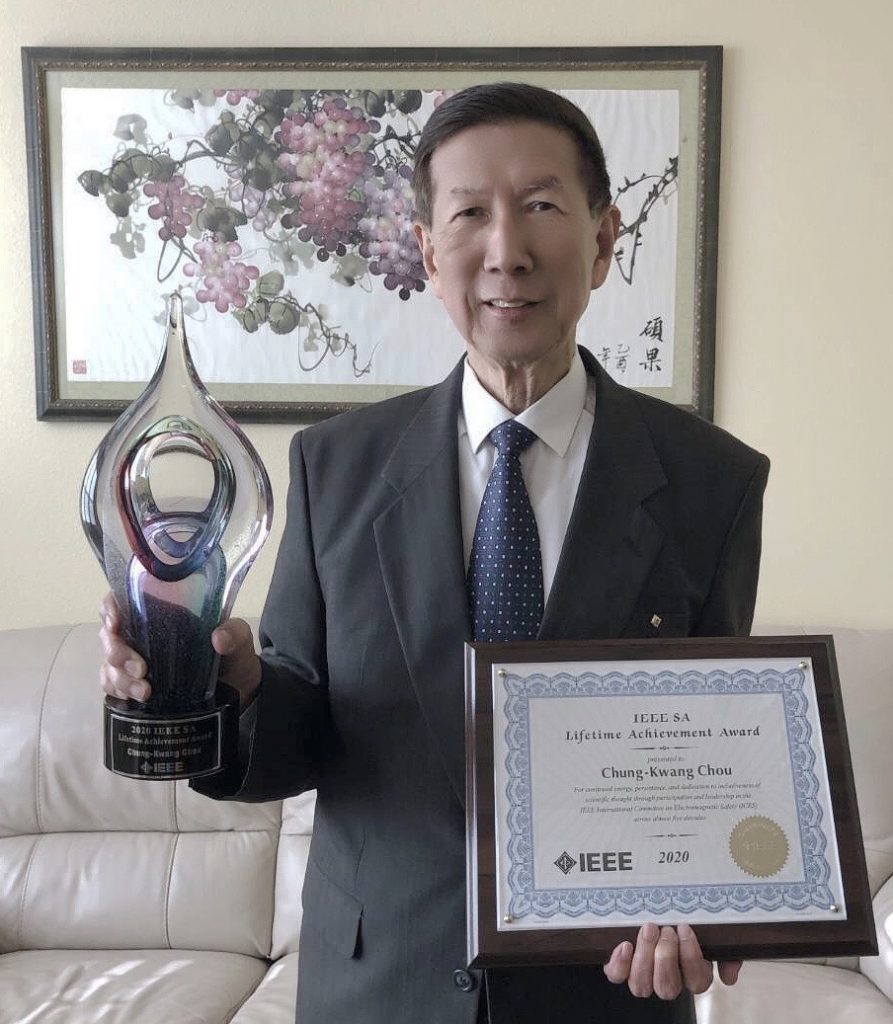
Dr. C-K. Chou posing for a photo with his IEEE SA Lifetime Achievement Award. (photo courtesy C-K. Chou)
For those of us who have ever watched TV, talked on a cellphone, enjoyed listening to AM/FM radio broadcasts or received an MRI scan, we can confidently do so with the understanding that these entirely commonplace and daily sorts of activities are safe for our bodies.
For this, we can credit University of Washington Department of Electrical & Computer Engineering (UW ECE) alum Dr. Chung-Kwang Chou (Ph.D. ’75) with helping to determine the safe levels of exposure to these types of electromagnetic-emitting technologies.
Through years of rigorous, evidence-based experiments, Chung-Kwang, or “C-K.” as many people know him, devoted his career to researching and measuring the effects of human and animal exposure to the electromagnetic field (EMF) energy emitted by such devices. Equally as important, he was also an instrumental figure in pushing for the worldwide adoption of IEEE safety standards related to their use.
In recognition of this critically important work, Chou was honored on January 5, 2021 with a prestigious 2020 IEEE Standards Association (IEEE SA) Lifetime Achievement Award for his “continued energy, persistence and dedication to inclusiveness of scientific thought through participation and leadership in the IEEE International Committee on Electromagnetic Safety (ICES) across almost five decades.”
“It is a great honor to receive this Lifetime Achievement Award,” Chou acknowledged in his acceptance speech. “Thank you to the IEEE Standards Association for developing technological standards for the benefit of humanity, and for the privilege that I can play a small part in it. Thank you.”
The IEEE SA Lifetime Achievement Award is presented annually to individuals who have dedicated over 15 years to standards development within IEEE and other national and international standards activities, and provided significant technical contributions to a standards committee or in their field of interest.
Pioneering safety standards
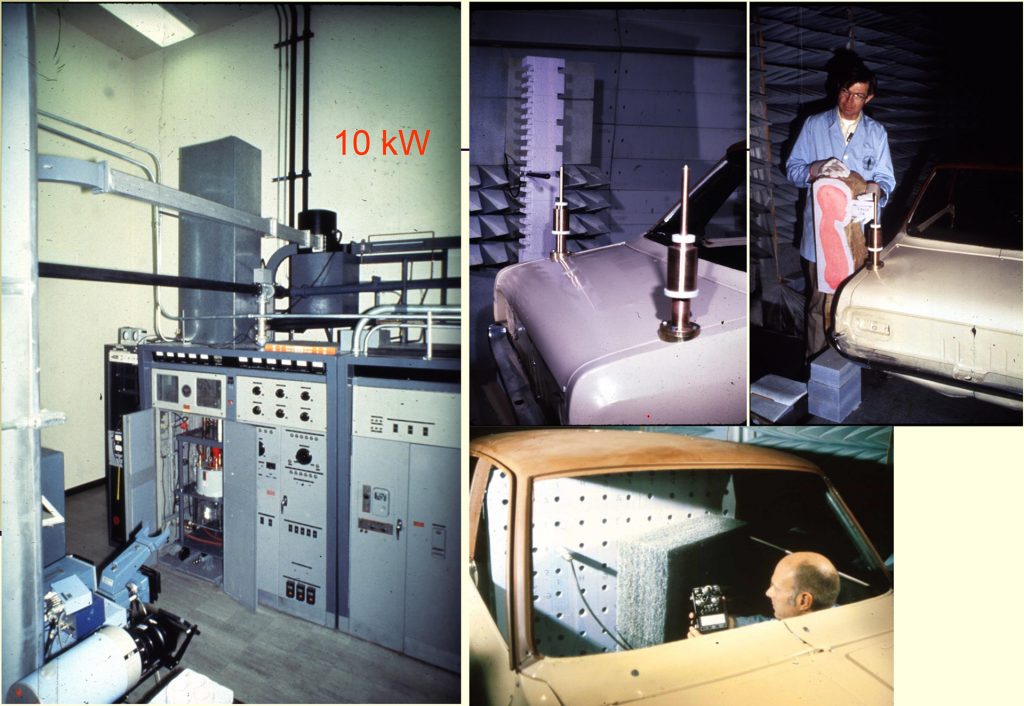
A 1981 study contracted by Bell Labs was conducted on the 4th floor of the EE building to research car-mounted UHF antenna energy absorption in humans, using a 10 kW generator as the source. The maximum allowed power output for this type of antenna was determined as a result of this study. (photos courtesy C-K. Chou)
Dr. Chou is perhaps best known for his research on the elusive auditory effect of radio-frequency (RF) exposure, or RF hearing, in which pulses of RF energy can cause a bizarre phenomenon of sounds such as clicks, buzzes, hisses, knocks, chirps, or even voices to be perceived inside of one’s own head under specific conditions.
Over the course of his nearly 50-year-long and hugely prolific career, Chou also contributed to the understanding of several other RF and microwave biological effects on humans, animals and cells, as well as RF dosimetry, MRI safety, exposure systems, and hyperthermia and electrochemical cancer treatments.
Chou’s education and training in the engineering and physiology sciences began with earning a bachelor of science degree in electrical engineering from National Taiwan University, Taipei (’68), followed by a master’s degree from Washington University in St. Louis (’71) and a doctorate at the University of Washington, Seattle (’75). He then spent a year as a National Institutes of Health (NIH) post-doctoral fellow in the regional primate research center at the UW Department of Physiology and Biophysics.
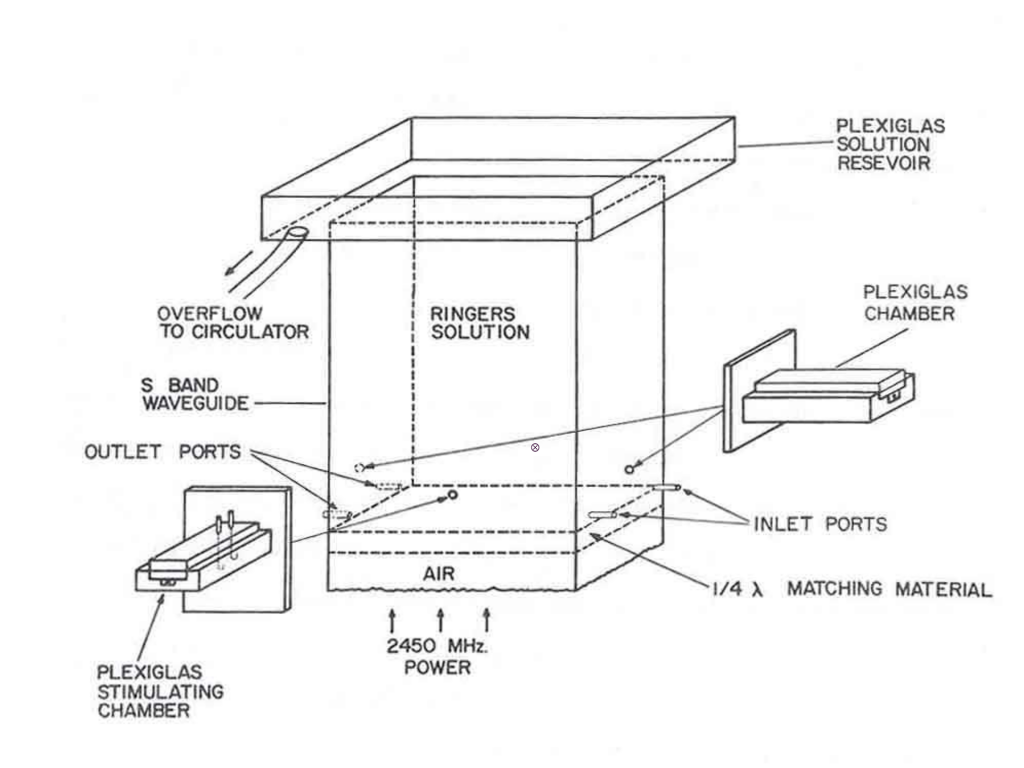
Chou’s first Ph.D. study was to verify if the claim of Soviet scientists – whether nerves are sensitive to microwave radiation – was correct. In 1971, he designed a temperature-controlled waveguide to expose nerves and muscles to intense microwave power. When keeping the temperature of the tissues constant, there were no effects from microwave exposure. Therefore, it was determined that it is the heat generated by microwaves themselves that causes effects on nerves and muscles. (image courtesy C-K. Chou)
Following his formal studies, Chou went on to serve as an assistant professor and later as a research associate professor at the Department of Rehabilitation Medicine and the Center for Bioengineering [now the Department of Bioengineering] at the UW from 1977 to 1985.
“I started my research at the Bioelectromagnetics (BioEM) Research Laboratory at the University of Washington, working between the labs of the UW Medical Center and the Electrical Engineering building [now Electrical & Computer Engineering],” explained Chou. “We pioneered a number of radio-frequency biological studies that produced results to help explain these RF effects on the human body.”
The IEEE lauded Chou as “a pioneer in both research and standardization related to human exposure to electromagnetic energy, or EME. He was deeply involved in early IEEE efforts to create EME exposure safety guidelines as a leader of the IEEE international committee on electromagnetic safety. He has been involved in its activities for nearly half a century, and has been a major contributor to the scientific foundation upon which safety standards for human exposure to non-ionizing electromagnetic fields are based. Additionally, he was instrumental in the creation of IEEE C95 standards on radio-frequency safety, both as a working group member and in leadership roles.”
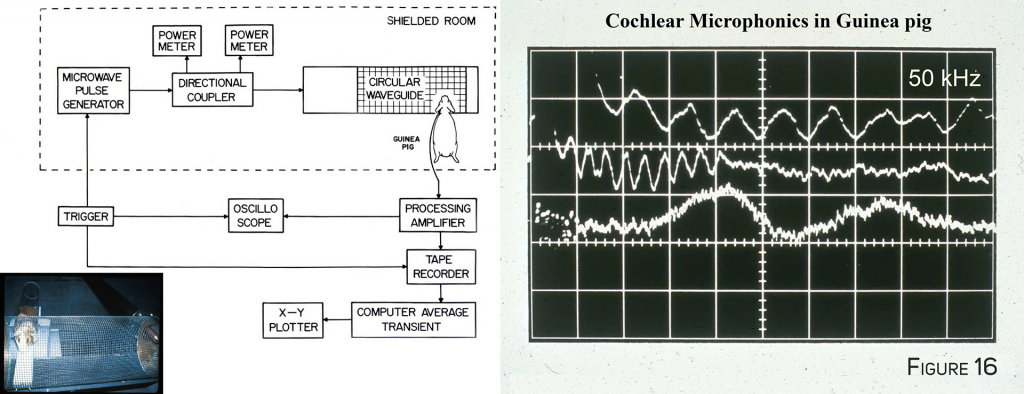
During the second half of his Ph.D. thesis, Chou researched the microwave auditory effect, which Americans working near radar transponders during World War II first reported, and was studied for many years by American researcher Alan Frey during the 1960s. Frey’s animal study results led him to believe the Soviets were right in believing that modulated radar pulses can trigger the auditory nerves to cause a perceptual phenomenon of hearing audible clicks, or even speech, inside of one’s head without the aid of electronic devices. However, Chou used various sizes of guinea pigs, cats and kittens to record their cochlear microphonics in order to disprove this nerve stimulation hypothesis, and was instead able to demonstrate that the phenomenon is due to thermoelastic expansion pressure inside of the head. Figure 16 shows the cochlear microphonic signal from a guinea pig at 50 kHz. The frequency of such hearing effect varies with the size of the head — in adult humans, for example, the expected perceived frequency is between 8 and 10 kHz. To this day, Chou is the only known individual to record microwave pulse-induced cochlear microphonics inside the cochleae of live animals, and his results were so consistent that the scientific community has since accepted it as a verifiable fact. (images courtesy C-K. Chou)
From academia to industry
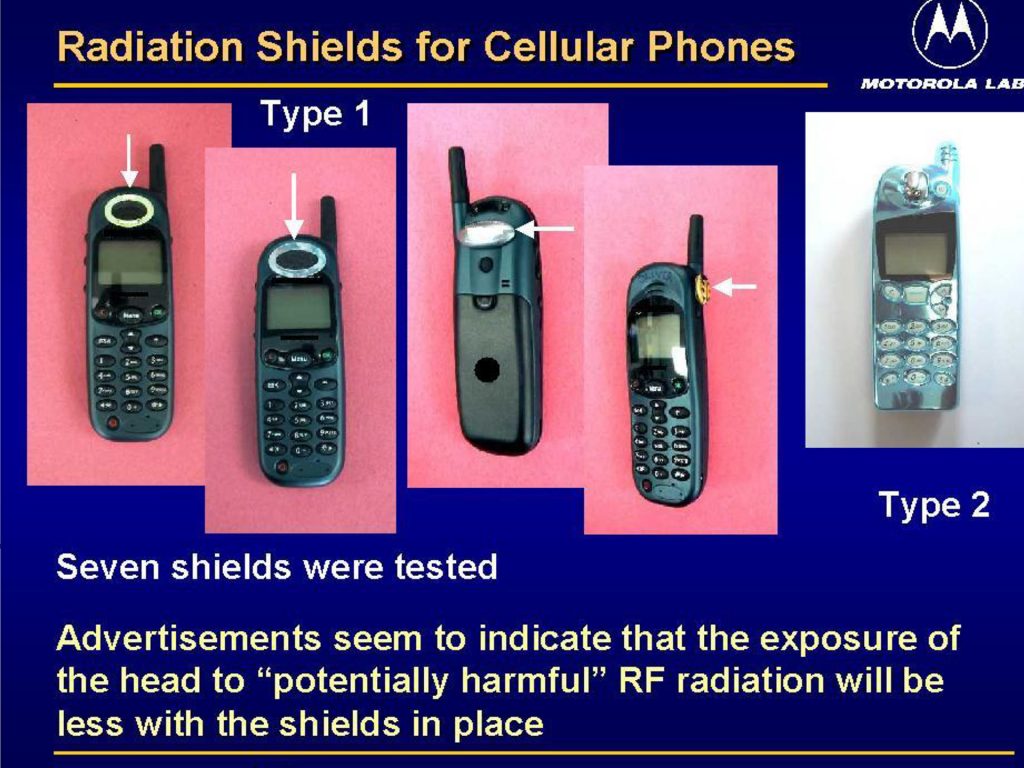
At Motorola, Chou conducted an experimental study to refute bogus safety and efficacy claims of small radiation shields placed on mobile phones. The study’s findings were presented at a 2001 conference and published in 2003, and the Federal Trade Commission (FTC) later used these results to fine three companies that were selling fake shielding stickers for reducing mobile phone “radiation.” (image courtesy C-K. Chou)
In the mid-1980s, Chou was recruited to direct the Department of Radiation Research at the City of Hope National Medical Center in Duarte, CA, bringing with him the years of expertise he’d fostered at the UW. Trading one sunny state for another, however, Chou was recruited once more in 1998, this time to join Motorola’s Florida Research Labs in Fort Lauderdale, FL. There, he became Chief EME Scientist and the Director of the Corporate EME Research Laboratory, responsible for RF product safety, until his retirement in 2013.
“It is ultimately important to develop standards, especially safety standards, based on solid scientific evidence.” -C-K. Chou
“In my many years of laboratory experience during my three jobs at the University of Washington, City of Hope National Medical Center, and Motorola, I learned the difficulties in conducting high-quality research in this field involving both biological and physical complexities,” said Chou, reflecting on his career. “Therefore, it is ultimately important to develop standards, especially safety standards, based on solid scientific evidence.”
Receiving the IEEE SA Lifetime Achievement Award is not the first time that Chou’s illustrious career in bioelectromagnetics has been recognized. In 2006, he was honored as the tenth recipient of the prestigious D’Arsonval Medal from the Bioelectromagnetics Society (BEMS) — the organization’s highest recognition of scientific excellence in the field.
“Over the decades, I have worked with and learned from many brilliant minds and committee members with a wide variety of engineering, scientific, and medical expertise. The happy collaborations with my colleagues made my research and my committee work very enjoyable,” Chou acknowledged.
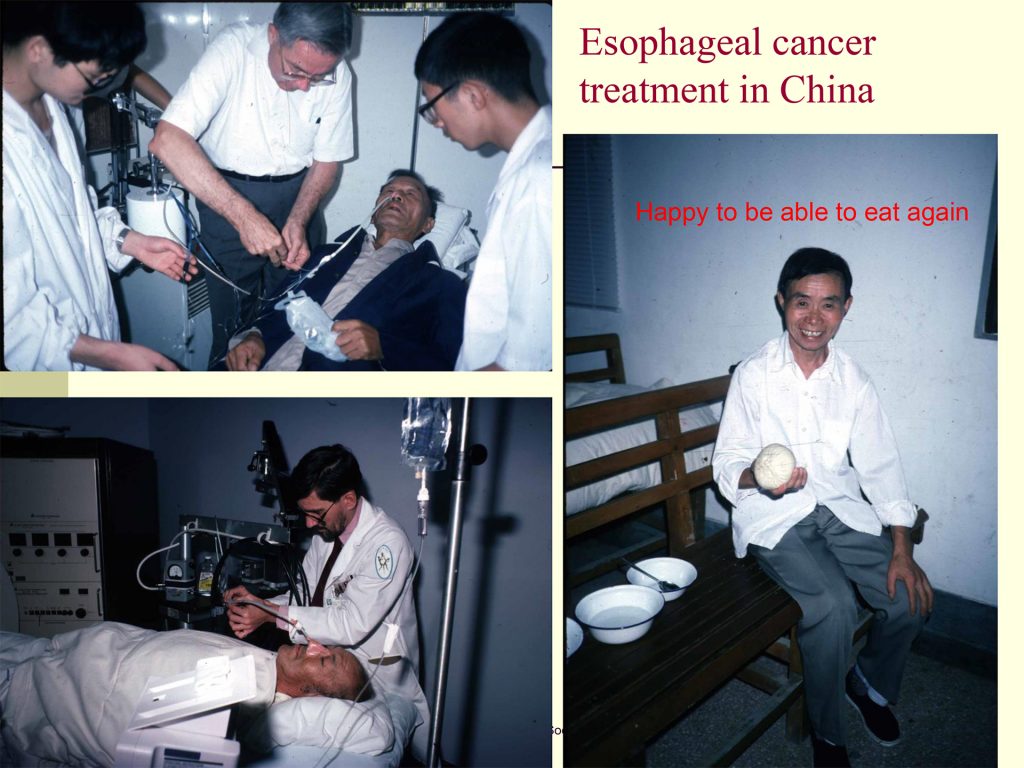
Esophageal cancer treatment of 25 patients in a military hospital in Nanjing, China, using a combination of intraluminal RF hyperthermia and radiation, 1994. The three-week-long study was supported by the National Cancer Institute. (photos courtesy C-K. Chou)
Acknowledging sources
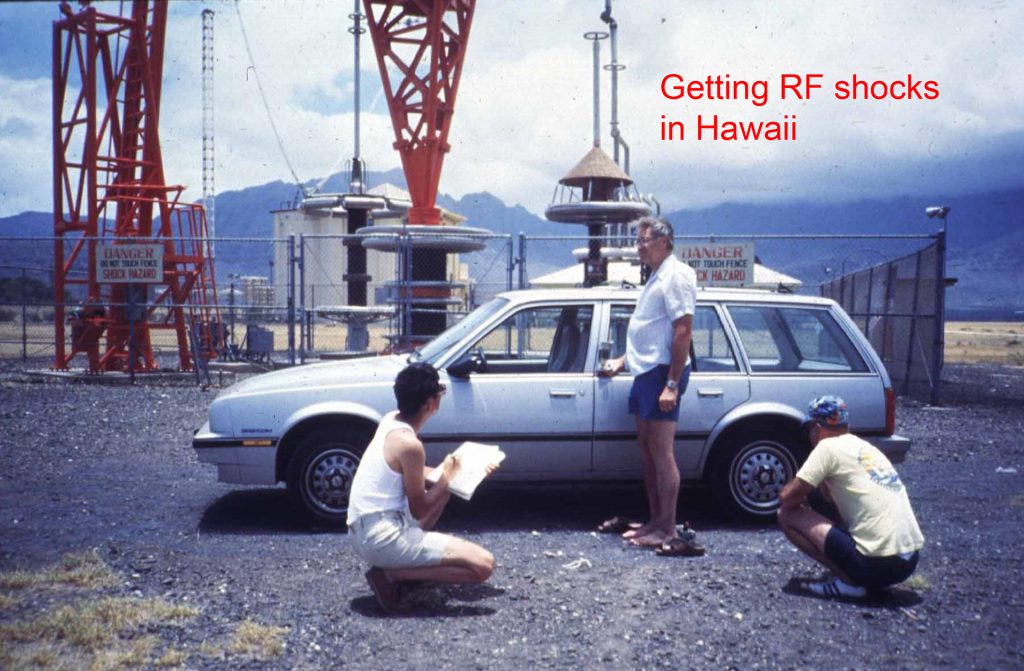
Under contract with the U.S. Air Force, Chou and Guy measured induced currents under high-power navigation communication antennae in Hawaii in 1982. For this project, they rented a series of different-sized vehicles, parked beneath the antennae of three stations with 10, 24.8 and 100 kHz broadcasting frequencies. Induced currents in their bodies were then measured either while wearing different types of footwear or standing barefoot on a chicken wire ground plane and touching the vehicles’ metal bodies. The most intense currents could be felt all the way into their upper arms when standing barefoot in a puddle of water, simulating conditions of a rainy day. The team “got lots of shocks that week” in the name of science! (photo courtesy C-K. Chou)
“When drinking water, one has to remember the source,” Chou elucidated while recognizing the impact of the education he received at UW ECE. “The University of Washington is the source of my achievements, and I’m very thankful to the professors who I studied under and worked with there.”
One such professor who was particularly influential in Chou’s decision to undertake the study of biological effects and medical applications of electromagnetic energy was his professor and mentor, the late Dr. Arthur “Bill” Guy. Chou had the privilege of working with Guy in the field of Bioelectromagnetics from 1971 to 1985 at the UW in the roles of both student and colleague. A UW ECE adjunct professor and faculty in the Department of Rehabilitation Medicine and Center for Bioengineering at UW, Guy was the second recipient of the D’Arsonval Medal in 1987 in recognition of his work.
“I have been fortunate to work in bioelectromagnetics since attending the University of Washington in 1971,” Chou explained. “My mentor, Dr. Bill Guy, not only advised me on my research, but also encouraged me to participate in IEEE standards activities, too.”
Another notably influential figure on Chou’s career was UW ECE Professor Emeritus Akira Ishimaru [see UW ECE’s The Integrator 2019 Trailblazers, page 45]. A National Academy of Engineering member and one of the world’s top experts in wave propagation and scattering in random and turbulent media, Ishimaru’s many accolades include receiving the 1999 IEEE Heinrich Hertz Medal, the International Union of Radio Science/Union Radio-Scientifique Internationale (URSI) Millennium Medal in 2000, and the UW College of Engineering’s 2011 Diamond Award, the highest honor given to its alumni.
“I learned all of my electromagnetics from Professor Ishimaru. He is my model, my hero.” -C-K. Chou
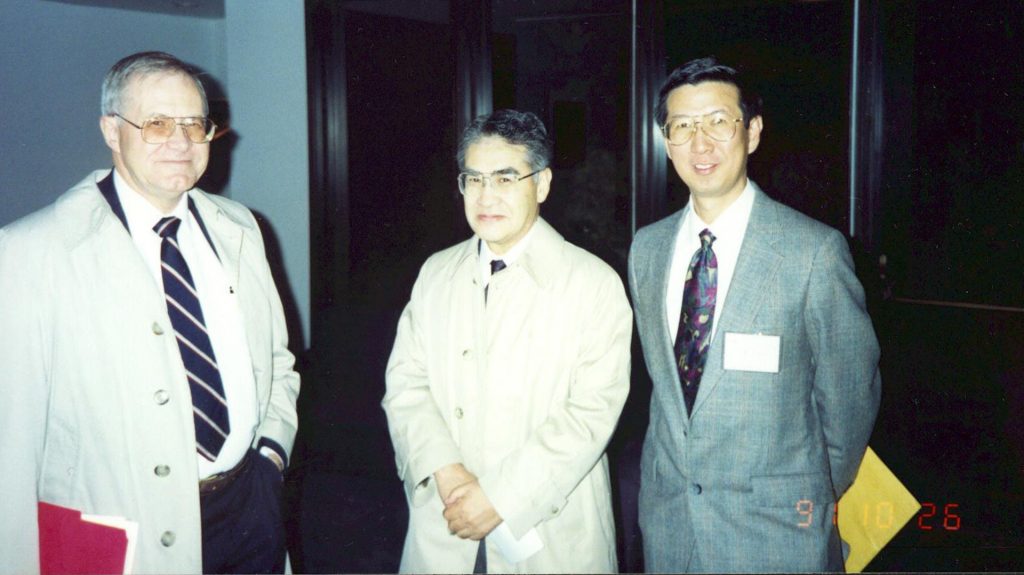
C-K. Chou with his two mentors and “heroes,” Dr. Bill Guy and UW ECE Professor Emeritus Akira Ishimaru, at Dr. Guy’s retirement party in 1991, which was organized by Chou. Left to right: Guy, Ishimaru and Chou. (photo courtesy C-K. Chou)
“When I was an EE student from 1971 to 1975, I took a series of electromagnetics courses from Professor Ishimaru, including wave propagation in random media. I had taken electromagnetics classes at other institutions, too, but did not find them interesting. Prof. Ishimaru changed that for me,” said Chou. “I learned all of my electromagnetics from Prof. Ishimaru, and he set an example for me in continuing a lifetime of research in my field. He is my model, my hero.”
Chou also appreciated the opportunity to work with Ishimaru in organizing the first Bioelectromagnetics Symposium, held in 1979 in conjunction with IEEE Antenna Propagation and National Radio Science and chaired by Ishimaru. Chou has since attended every subsequent Bioelectromagnetics meeting for the past 42 years.
Continued activities in energy and engineering
With arguably even more energy than the technologies he researches, Dr. Chou continues to be a highly active figure in the field well into his retirement, working as an independent consultant on EMF safety issues.
In addition to serving on the board of BEMS, Chou is also a fellow of IEEE, the American Institute for Medical and Biological Engineering (AIMBE), and the Electromagnetic Academy. He has served as the Chairman of TC 95 of the International Committee on Electromagnetic Safety of IEEE since 2006, responsible for exposure standards from 0 to 300 GHz; and he has served on the Advisory Panel of Non-Ionizing Radiation of NCRP and as a Distinguished Lecturer of IEEE Broadcast Technology Society since 2016.
Additionally, Chou served as Co-Chairman of IEEE Scientific Coordinating Committee 28, Subcommittee 4 on RF Safety Standard (1997- 2005); was Vice Chairman of Committee 89-5 of the National Council on Radiation Protection and Measurements (1996-1999); was Council Member of NCRP (1998-2004); and from 1994 to 1999 he served as Vice-Chair, Chair and Past Chair for the Committee on Man and Radiation (COMAR) of the Engineering in Medicine and Biology Society of IEEE, a group of experts on health and safety issues related to electromagnetic fields, from power line to microwave-frequency ranges.
After retiring from Motorola in 2013, Dr. Chou and his wife of nearly fifty years, Grace, moved back to California to be closer to their two children and grandson. They currently reside in the Bay Area.
Click to view a full list of the 2020 IEEE SA Awards categories and recipients and watch Dr. Chou’s award recognition and acceptance speech. IEEE SA awards are bestowed upon eligible individuals, IEEE SA members and/or member organizations. This year’s awards ceremony was held virtually due to the restrictions imposed by the ongoing COVID-19 pandemic. Congratulations, Dr. Chou!
IEEE is the world’s largest technical professional organization, and the IEEE Standards Association (IEEE SA) is a leading consensus-building organization that nurtures, develops and advances global technologies through IEEE. The IEEE SA brings together a broad range of individuals and organizations from a wide range of technical and geographic points of origin to facilitate standards development and standards-related collaboration.

